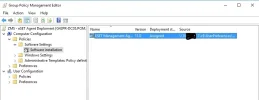ajeesh thazthethil
New Member
- Joined
- May 21, 2024
- Messages
- 4
- Thread Author
- #1
Re: eSET Agent Software installation using GPO
1. Created the GPO for eSET auto installation
2. Given the share folder path which contains the agent.msi and .ini files
3. Applied the GPO to the particular computer OU
4. Updated the GPO on the client compute and checked the GPO has been taken place
5. Client computer asked for the reboot
Proceed with all the above steps however, the client system is still unable to install the eSET agent.
Every GPO update the system asking to reboot. Please advise
1. Created the GPO for eSET auto installation
2. Given the share folder path which contains the agent.msi and .ini files
3. Applied the GPO to the particular computer OU
4. Updated the GPO on the client compute and checked the GPO has been taken place
5. Client computer asked for the reboot
Proceed with all the above steps however, the client system is still unable to install the eSET agent.
Every GPO update the system asking to reboot. Please advise

